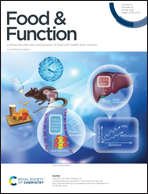A comparative study of the effects of phosphatidylserine rich in DHA and EPA on Aβ-induced Alzheimer's disease using cell models†
Abstract
Alzheimer's disease (AD) is an age-dependent, irreversible neurodegenerative disease, and one of the pathological features is amyloid-β (Aβ) deposition. Previous studies have shown that phosphatidylserine (PS) enriched with eicosapentaenoic acid (EPA) and docosahexaenoic acid (DHA) exhibited significant effects in preventing and alleviating the progress of AD. However, no studies have focused on the differences in the preventive effects on AD between EPA-PS and DHA-PS. Here, the effects of EPA-PS and DHA-PS on Aβ production, Aβ-induced neurotoxicity and Aβ clearance have been studied. The results show that DHA-PS significantly reduced Aβ production in CHO-APP/PS1 cells compared to EPA-PS. Moreover, both EPA-PS and DHA-PS significantly protected the primary hippocampal neurons against Aβ-induced toxicity by inhibiting the mitochondrial-dependent apoptotic pathway and phosphorylation of JNK and p38. Compared to DHA-PS, EPA-PS administration significantly improved the Aβ phagocytic capacity of BV2 cells. In addition, EPA-PS and DHA-PS significantly promoted the neurite outgrowth of primary hippocampal neurons. These findings might provide dietary guidance for the prevention of AD as well as a reference for the development of related functional foods.



 Please wait while we load your content...
Please wait while we load your content...